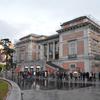More about Prince Baltasar Carlos on Horseback
- All
- Info
- Shop

Contributor
The Equestrian Portrait of Prince Balthasar Charles was created by Velázquez during a relatively prolific decade for the artist, during which he produced one-third of his works, which most scholars number only around 115 in total.
The patron of Velázquez, Philip IV of Spain, who was also king of Portugal under the title Philip III, was a member of the Habsburgs, a dynasty whose "preeminence was longer lasting, and...ambitions more grandiose, than any other modern royal family." Patrons of Titian, Raphael, and Klimt, among many others, the Habsburgs were "sure that they were born to rule." The subject of the portrait is Philip's son, Balthasar Carlos, anglicized as Balthasar Charles, his heir apparent, as the only male of the eight children born to the union of Philip and his wife, Elisabeth of France.
Between 1632 and 1637, the king directed teams of architects and artists in the construction of his second home, the Buen Retiro Palace, the extensive gardens of which are now a public park in Madrid. The gardens were the hunting grounds for the king, the prince, and their large entourage. The king requested over 1,000 canvases for display in the palace, and during this time he "forced" Velázquez to "remain at his easel, producing picture after picture," including the Equestrian Portrait of Balthasar Charles. This kind of extravagant behavior added force to the criticisms of the king's Protestant and Republican adversaries, and ultimately hastened the downfall of the Habsburgs and their way of life.
The major commission of Velázquez for the palace included "five large equestrian portraits of Philip III and Margarita of Austria, of Philip IV and Isabella of Bourbon, and of Balthasar Carlos" in 1634, due for installation the following year. The Equestrian Portrait of Balthasar Charles was one of only two in the series composed entirely by Velázquez himself; the rest were creative reinterpretations of existing portraits, painted by anonymous court painters.
The military power and ambition of the Habsburg family was a major cause of the Thirty Years' War, the most devastating war on earth until WWII. In the wake of the Thirty Years' War, the monopolistic influence of the Habsburgs went into decline. This gave King Philip a motive to support the work of Velázquez, in exchange for a series of commissioned portraits of the royal family. The brevity and tragedy of the life of Balthasar Charles, a teenage casualty of smallpox, was another blow to feudalism in general and the Habsburgs in particular.
Sources
- Bailey, Anthony. Velázquez and the Surrender of Breda: The Making of a Masterpiece. New York: Henry Holt & Co., 2011.
- Brown, Jonathan. Collected Writings on Velázquez. New Haven: Yale University Press, 2008.
- Curtis, Benjamin. The Habsburgs: The History of a Dynasty. London: Bloomsbury Publishing, 2013.
- Jones, Jonathan. "The Habsburgs shaped the story of Europe – and of its art." The Guardian, Jul. 25, 2011, https://www.theguardian.com/artanddesign/jonathanjonesblog/2011/jul/25/…
Featured Content
Here is what Wikipedia says about Equestrian Portrait of Prince Balthasar Charles
The Equestrian Portrait of Prince Balthasar Charles is a portrait of Balthasar Charles, Prince of Asturias on horseback, painted in 1634–35 by Diego Velázquez. It is now in the Prado Museum.
Check out the full Wikipedia article about Equestrian Portrait of Prince Balthasar Charles













